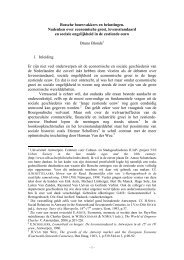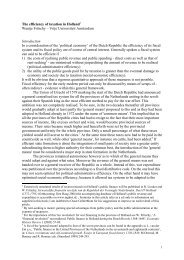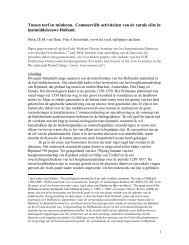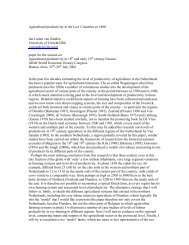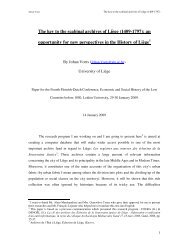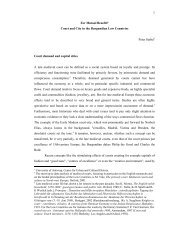Amsterdam as the cradle of modern futures and options trading ...
Amsterdam as the cradle of modern futures and options trading ...
Amsterdam as the cradle of modern futures and options trading ...
You also want an ePaper? Increase the reach of your titles
YUMPU automatically turns print PDFs into web optimized ePapers that Google loves.
82 The forward contract: BT 112/c2 (26 August 1611); The future contract: BT 112/c2 (10 December 1610).<br />
Besides, Thijs’ papers contain several written <strong>and</strong> printed transfer deeds <strong>of</strong> shares issued by <strong>the</strong> VOC. The oldest<br />
transfer deeds are three printed forms for <strong>the</strong> transfer <strong>of</strong> VOC shares in <strong>the</strong> VOC chamber <strong>of</strong> Enkhuizen, dated<br />
August 27, 1604 (twice), <strong>and</strong> July 11, 1616. There are also two written transfer deeds from <strong>the</strong> same chamber,<br />
dated February 22, <strong>and</strong> August 19th, 1611. Finally <strong>the</strong>re is a printed transfer deed, from <strong>the</strong> <strong>Amsterdam</strong> chamber<br />
<strong>of</strong> <strong>the</strong> company, for a share bought by Thijs on December 9, 1610 (BT 112, c2)<br />
83 See for a similar sale <strong>of</strong> a forward contract, completed before an <strong>Amsterdam</strong> notary: ACA NA 707/908, 01-<br />
11-1630.<br />
84 The exact wording w<strong>as</strong>: “t’oorconde der waerheyt syn hier affgemaeckt, twee alleensluydende contracten,<br />
wtten <strong>and</strong>eren gesneden door A B C D ende by parthyen respective onderteeckent, daervan elcx eeen heeft...”<br />
(BT 112/c2, nr. 5).<br />
85 ACA NA 196/480, 05-05-1610; Cf. also Van Dillen, ‘Isaac le Maire’, 92-93.<br />
86 On <strong>the</strong> transfer <strong>of</strong> notarized <strong>and</strong> private contracts: Van Dillen, ‘Isaac le Maire’, 78-83, 89-91, 92-93, 100.<br />
87 Smith, Tijdaffaires 57-59/ The contracts are held in <strong>the</strong> <strong>Amsterdam</strong> town record <strong>of</strong>fice. One <strong>of</strong> <strong>the</strong>m may be<br />
seen at http://gemeentearchief.amsterdam.nl/schatkamer/index.nl.html. It w<strong>as</strong> published in facsimile by Van<br />
Dillen, ‘Isaac le Maire’ (between pp. 12 <strong>and</strong> 13).<br />
88 A.E. Sayous, ‘La liquidation des marchés à terme sur march<strong>and</strong>ise en Holl<strong>and</strong>e entre 1675 et 1725’, Nouvelle<br />
Revue d’histoire du Droit 25 (1901), 767-773; The oldest reference to clearing (rescontreren) in <strong>Amsterdam</strong>’s<br />
local customs dates from 1635 (Smith, Tijd-affaires, 6n)<br />
89 For example, in February 1611 Hans Thijs had bought a share <strong>of</strong> 9,000 guilders from Jan Brouwer, part <strong>of</strong><br />
which he immediately resold to a third party. Brouwer agreed to deduct a payment promised by this third party<br />
from his claim on Hans Thijs, “<strong>as</strong> if it had already been paid to him” (BT 112/c2).<br />
90 Van Dillen, ‘Isaac le Maire’, 20, 22<br />
91 J.I. Israel, Dutch primacy in world trade (Oxford UP: Oxford 1989), 74.<br />
92 The <strong>Amsterdam</strong> notarial records hold many deeds in which brokers testify about share prices; <strong>the</strong> earliest<br />
known is ACA NA 336/15, 11 July 1613.<br />
93 On <strong>the</strong> obligation <strong>of</strong> brokers to keep records <strong>of</strong> <strong>the</strong>ir transactions: Noordkerk, H<strong>and</strong>vesten, 1060-1074. When<br />
<strong>the</strong> <strong>Amsterdam</strong> Exchange opened its doors in 1611, it had rooms for meetings <strong>of</strong> merchants <strong>and</strong> brokers. In 1632<br />
<strong>the</strong> brokers’ guild built a new guild house which had meeting room at <strong>the</strong> first floor. Th. Stuart, De <strong>Amsterdam</strong>se<br />
makelaardij: bijdrage tot de geschiedenis onzer h<strong>and</strong>elswetgeving (<strong>Amsterdam</strong> 1879), 52-53. “Es gab Makler,<br />
welche “rescontrantes” hießen, weil sie es übernahmen, die Partien nach Möglichkeit gegenein<strong>and</strong>er<br />
auszugleichen, die Differenzen (surpluses) einzuk<strong>as</strong>sieren und auszuzahlen.” (Ehrenberg, ‘<strong>Amsterdam</strong>er’, 819).<br />
The 1739 agreement about settling <strong>options</strong> published by Smith, Tijdaffaires 126-129.<br />
94 ACA NA 335/130, 10-09-1612; ACA NA 197/512v, 15-03-1613; DNA 1.04.02 Inv. Nr. 7066, fol. 203, 208,<br />
305, 325, 330; Cf. also Van Dillen, ‘Isaac le Maire’, 90, 95, 100; At various occ<strong>as</strong>ions brokers appeared before a<br />
notary to describe current market conditions. See for example: ACA NA 336/15; 11-07-1613; ACA NA 694b/<br />
omslag 60, 21-02-1634; ACA NA 1059/13, 19-12-1640<br />
95 Ehrenberg ‘<strong>Amsterdam</strong>er’, 825 ; Smith, Tijd-affaires, 47. The deed ACA NA 336/15, 11 July 1613<br />
specifically refers to <strong>the</strong> witnesses appearing <strong>as</strong> stock brokers.<br />
96 Isaac Florianus, admitted 27 Januari 1612 (ACA 366/1071, fol. 71; Also: NA 197/512v); Jacques (van) de<br />
Geer, admitted 27 Januari 1612 (ACA 366/1071, fol. 71; Also NA 335/130); Pieter van Haren, 06-02-1612<br />
(ACA 366/1071, fol. 133; Also: NA 336/15); Reijnier Lems, <strong>the</strong> former bookkeeper <strong>of</strong> Lemaire’s syndicate, w<strong>as</strong><br />
admitted 27 July 1613 (ACA 366/1071, fol. 147; Also: Van Dillen, ‘Isaac le Maire’, p<strong>as</strong>sim)<br />
97 Statement by Isaac Florianus, 26-08-1611 (BT 112/c2)<br />
98 Lane <strong>and</strong> Mueller, Venetian Money Market, 571<br />
99 De Groot, Zee<strong>as</strong>surantie, 133.<br />
100 Gelderblom, ‘Governance’, p<strong>as</strong>sim.<br />
101 The most recent overall description is D<strong>as</strong>h, Tulipomania; Cf. also Krelage, Bloemenspeculatie, <strong>and</strong> idem,<br />
‘Manuscript’; Posthumus, ‘Speculatie’.<br />
102 The workings <strong>of</strong> <strong>the</strong> <strong>trading</strong> clubs is explained by Posthumus, ‘Speculatie’, I 12-17.<br />
103 Cf. for instance Posthumus, ‘Speculatie’, I, 11-15; D<strong>as</strong>h, Tulipomania, chapter 10; Krelage,<br />
Bloemenspeculatie 70-72.<br />
104 We will focus our analysis on <strong>the</strong> <strong>trading</strong> techniques in <strong>the</strong> market for tulips. There is also a c<strong>as</strong>e for <strong>the</strong><br />
normality <strong>of</strong> <strong>the</strong> tulip prices. Peter Garber h<strong>as</strong> argued convincingly that <strong>the</strong> price rises in <strong>the</strong> tulip market were a<br />
normal phenomenon given that a host <strong>of</strong> new varieties <strong>of</strong> tulips appeared on <strong>the</strong> market: P.M. Garber<br />
‘Tulipmania’, The Journal <strong>of</strong> Political Economy, 97:3 (1989), 535-580. Marina Bianchi recently argued that<br />
prices remained high for <strong>the</strong> ple<strong>as</strong>ure people derived from <strong>the</strong> never ending appearance <strong>of</strong> new variations: M.<br />
Bianchi, “In <strong>the</strong> name <strong>of</strong> <strong>the</strong> tulip. Why Speculation?”, in: M. Berg <strong>and</strong> H. Clifford, Consumers <strong>and</strong> luxury.<br />
Consumer culture in Europe 1650-1850 (Manchester University Press: Manchester 1999), 88-102<br />
24



